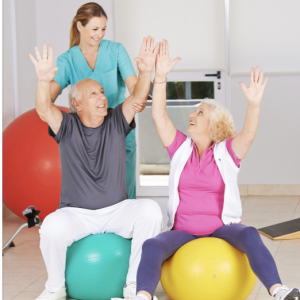Land On Your Feet: Exercises To Support Balance And Prevent Falls

Land On Your Feet: Exercises To Support Balance And Prevent Falls
January 19, 2022
It’s almost a rite of passage: Reach a certain age, take a stumble, and a serious injury is almost inevitable. The data alone are worth repeating: One in four adults 65 and over suffers a fall each year and 3 million adults over 65 wind up in the hospital ER as a result of that fall. Further, it’s estimated that over 30,000 older adults die each year due to a fall. The reasons so many of us fall? How well we walk and maintain our balance is an interplay between multiple systems in our body: the brain, the nervous system, our sensory organs (eyes and ears), and our musculoskeletal system, not to mention underlying medical conditions that may leave us weak or disoriented. Problems with any of these, and you’re at risk for a fall.
Whether it’s medication side effects, loss of leg strength, or vision problems that affect your ability to navigate your environment, you need to do all you can to lessen the causes and strengthen your defenses against a serious fall. There are many proactive measures to take in your environment to lessen risks, such as improving lighting, clearing clutter, keeping commonly-used objects easily accessible, and installing grab bars wherever you may need a hand. For a quick graphic to get you up to speed on fall prevention measures, click here. The CDC also has a resource page designed to instruct you and your loved ones on the best ways to proactively prevent falls. Of course, previously, we’ve discussed the need to review medications that may be unnecessary and cause you to be at risk for a fall.
But perhaps one of the best ways to both minimize risk and improve your ability to withstand a fall (and limit the damage) is through physical exercise, focusing on both strength and balance. There are a host of resources and recommendations to guide you to the best exercises for strengthening your upper and lower legs, improving your balance, and building your core– so that you avoid back pain and injury as you improve your ability to prevent and withstand a fall. For example, Dr. Leslie Kernisan from Better Health While Aging provides videos on her website from the Carolina Geriatric Education Center that cover a range of fall-related issues, from assessment of risk (with the recommendation that you should always start with a physical therapist before you take on an exercise routine), to warm up, to strengthening and then on to balance. To watch these videos, pull up a sturdy chair and click here. The wellness website Spiro100 also offers a package of online subscription exercise classes for older adults, including a variety of classes designed to address fall prevention.
For some informative articles that include visual illustrations of exercise poses, consider this recent Wall Street Journal article (paywall), Six Exercises to Help Seniors Build Strength, Improve Balance and Prevent Falls, or the recent and comprehensive article in US News entitled 9 Best Exercises for Preventing Falls in Older Adults. Of course, there’s one simple exercise you can do every day, on your own, while doing something as simple as brushing your teeth. Just stand on one leg (with a counter or chair to reach for should you falter). Practicing this one pose daily will allow you to build up strength in your legs, improve your balance and lessen the likelihood of an injurious fall. And if you want to up the challenge? Try closing your eyes while standing on one leg (but make sure you feel steady enough to try this)!







